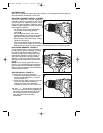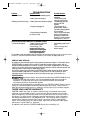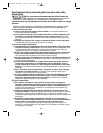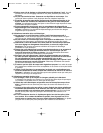
11
SCREW DRIVING
For driving fasteners, the reversing button should be pushed to the left. Use reverse
(button pushed to the right) for removing fasteners. When moving from forward to
reverse, or vice versa, always release the trigger switch first.
ON BOARD BIT STORAGE
A bit storage slot is built-in to the area just above the battery.
DRILLING
• Use sharp drill bits only.
• Support and secure work properly, as instructed in the Safety Instructions.
• Use appropriate and required safety equipment, as instructed in the Safety Instructions.
• Secure and maintain work area, as instructed in the Safety Instructions.
• Run the drill very slowly, using light pressure, until the hole is started enough to keep
the drill bit from slipping out of it.
• Apply pressure in a straight line with the bit. Use enough pressure to keep the bit biting
but not so much as to stall the motor or deflect the bit.
• Hold the drill firmly with one hand on the grip and the other hand on the bottom of the
battery pack to control its twisting action.
• DO NOT CLICK THE TRIGGER OF A STALLED DRILL OFF AND ON IN AN
ATTEMPT TO START IT. DAMAGE TO THE DRILL CAN RESULT.
• Minimize stalling on breakthrough by reducing pressure and slowly drilling through the
last part of the hole.
• Keep the motor running while pulling the bit out of a drilled hole. This will help reduce
jamming.
• Make sure switch turns drill on and off.
DRILLING IN WOOD
Holes in wood can be made with the same twist drill bits used for metal or with spade
bits. These bits should be sharp and should be pulled out frequently when drilling to
clear chips from the flutes.
DRILLING IN METAL
Use a cutting lubricant when drilling metals. The exceptions are cast iron and brass
which should be drilled dry. The cutting lubricants that work best are sulfurized cutting oil
or lard oil.
DRILLING IN MASONRY
Use carbide tipped masonry bits. Refer to Drilling section. Keep even force on the drill
but not so much that you crack the brittle material. A smooth, even flow of dust indicates
the proper drilling rate.
THE RBRC™ SEAL
The RBRC™ (Rechargeable Battery Recycling Corporation) Seal on the
NI-CD battery (or battery pack) indicates that the costs to recycle the battery
(or battery pack) at the end of its useful life have already been paid by
PORTER-CABLE.
RBRC™ in cooperation with PORTER-CABLE and other battery users, has established
programs in the United States to facilitate the collection of spent NI-CD batteries. Help
protect our environment and conserve natural resources by returning the spent NI-CD
battery to an authorized PORTER-CABLE service center or to your local retailer for
recycling. You may also contact your local recycling center for information on where to
drop off the spent battery.
RBRC™ is a registered trademark of the Rechargeable Battery Recycling Corporation.
MAINTENANCE
Use only mild soap and damp cloth to clean the tool. Never let any liquid get inside the
tool; never immerse any part of the tool into a liquid.
REPLACEMENT PARTS
Use only identical replacement parts. For a parts list or to order parts, visit our service website at
www.portercable.com. You can also order parts from your nearest PORTER-CABLE Factory
Service Center or PORTER-CABLE Authorized Warranty Service Center. Or, you can call our
Customer Care Center at (888) 848-5175.
90550129 PC1800D 4/1/09 2:38 PM Page 11


















